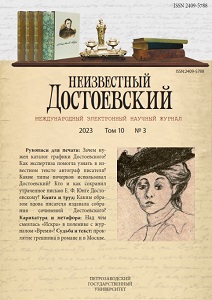Электронный каталог графики Ф. М. Достоевского: знак, буква, текст
Electronic Catalog of F. M. Dostoevsky’s Graphics: Sign, Letter, Text
Author(s): Tatyana Viktorovna PanyukovaSubject(s): Semiotics / Semiology, Cataloguing, Russian Literature, 19th Century
Published by: Петрозаводский государственный университет
Keywords: Dostoevsky; notebooks; electronic catalog of graphics; textual studies; codicology; handwriting; cursive writing; calligraphy; onomastics; author’s marks; attribution; author’s style;
Summary/Abstract: Based on the digital archive of F. M. Dostoevsky, containing images and research transcripts of the texts of his notebooks (http://dostoevsky-archive.ru/), work was underway to create a commented corpus of the writer’s graphics in 2020–2023. This article discusses issues that have arisen in the course of practical work on filling the catalog of graphic samples, indicates possible ways to solve them, identifies ways to use the created online database. One of the main practical applications of the developed platform was the ability to use special tools to recognize hard-to-read Dostoevsky records. The choice of the description unit became important: instead of the minimum spelling unit — grapheme, the grammatical category of word forms was used. The emphasis on the word as the main unit of description created conditions for the gradual selection of material for an online dictionary of the writer’s manuscripts, if necessary, coordinating the requirements for graphics (as a description of the external features of the text, sketches) and grammar (as a structure-forming principle). The search for ways to solve the issues that arose resulted in the description of individual word forms: semantic homographs that are different parts of speech, suppletive forms of a word, proper names (including anthroponyms, toponyms, common names, as well as appellatives that are equivalents of proper names — this creates prerequisites for creating a dictionary of names inside the online dictionary of manuscripts). Structurally complex lexical units are also described as a single word form: polynomial synonyms, names, complex conjunctions and prepositions, introductory and phraseological combinations. A separate promising group for the study consisted of Dostoevsky’s author’s signs, hybrid in form: these include both words (“February”) and author’s signs (as symbols or proof-reading signs). When describing Dostoevsky’s calligraphic works, on the one hand, it became obvious that it was necessary to differentiate the variants of the writer’s calligraphic inscriptions, systematize the available knowledge about the peculiarities of his calligraphic handwriting and determine the criteria for selecting and describing the material. On the other hand, it turned out to be possible to use the samples already available in the database as the basis for the attribution of autographs and stationery copies in Dostoevsky’s handwritten legacy. Thus, the created electronic database of Dostoevsky’s graphics turned out to be the optimal platform for solving multidirectional tasks — codicology, textual studies, the study of the author’s language and style, attribution, scientific commentary, onomastics — and, thanks to the software potential embedded in it, has fairly extensive development prospects.
Journal: Неизвестный Достоевский
- Issue Year: 10/2023
- Issue No: 3
- Page Range: 5-25
- Page Count: 21
- Language: Russian

